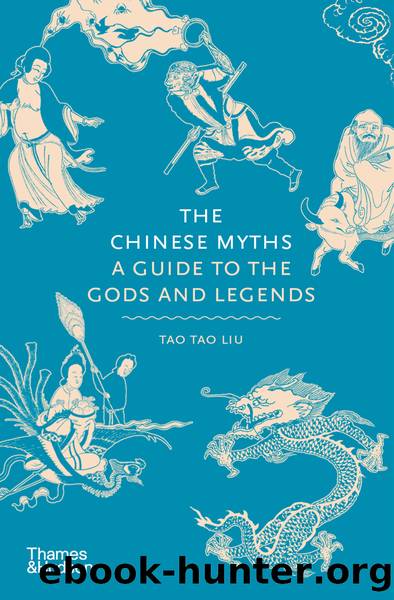The Chinese Myths by Tao Tao Liu;

Author:Tao Tao Liu;
Language: eng
Format: epub
Publisher: Thames & Hudson Ltd.
Published: 2022-12-15T00:00:00+00:00
âNow I understand.â â Yu then married a girl from Tushan, and called her Nujiao (âBeautiful Girlâ).
Yan Shiku (581â645 BCE) continues the story in a no longer extant passage of the Huainanzi: âWhile Yu was making the channels for the water, he turned into a bear in order to get a greater purchase on the stones. He had told the Tushan Girl, who was bringing food to him, that he would beat on a stone drum when it was time for her to come. When he was at his task, he accidentally drummed on a stone. When the Tushan Girl heard this, she thought it was the arranged signal to bring him food, but fled in fright and horror at the sight of the bear. Yu chased after her till she turned to stone. Then he cried out, âGive me back my sonâ, for when she fled she was heavily pregnant. The stone split open and his son, Qi, was born. The name means âOpenâ. â
Yu took nine years to successfully conquer the waters, and then he commanded Tai Zhang, one of his ministers, to measure the land. From the east pole to the west, it measured 233,575 paces. He commanded another minister, Shu Hai, to measure 233,575 paces from the north pole to the south. Finally, from the deepest abyss of the flood, above twenty-four feet, Yu measured 233,559 paces. Then Yu damned the flood waters with the Supreme Godâs magical xirang, and thus created the mountains. In this way he created the Nine Provinces of China. The Nine Provinces was a term used to designate the area controlled by the Shang dynasty, but as more areas were brought under Chinese control in the Zhou and later, the term became obsolete by the Three Kingdoms period.
Having established the land of China, Yu travelled to more distant regions, largely in search of knowledgeable souls who might help the Chinese people extend the use of their fields. We learn of the lands Yu visited from pseudo-geographical books. For instance, the Lushi Chunqiu (âMaster Luâs Annals of Spring and Autumnâ), compiled around 139 BCE, tells us of his trip to âthe land where people had Black Teethâ. The Shan Hai Jing (âClassic of Mountains and Seasâ) mentions one place where people had holes exposed in their breasts, and another where people had only one arm but three eyes. Most of these places are obviously mythical, but some are still recognizable, especially those containing the names of rivers. Many of these places were great objects of Chinese curiosity. Those that have been tentatively identified include the silk-producing area of Sichuan and Dunhuang in the far northwest, as well as areas on Chinaâs borders such as Korea, Khotan and India, âthe land of sky-poisonâ.
The Nine Tripod Cauldrons
Yu was also believed to have cast the Nine Tripod Cauldrons. These elaborate cauldrons, or ding, were made of gold that had been amassed as tribute from the Nine Provinces. According to the Zuo Zhuan (âZuo Traditionâ) they
Download
This site does not store any files on its server. We only index and link to content provided by other sites. Please contact the content providers to delete copyright contents if any and email us, we'll remove relevant links or contents immediately.
| Buddhism | Christianity |
| Ethnic & Tribal | General |
| Hinduism | Islam |
| Judaism | New Age, Mythology & Occult |
| Religion, Politics & State |
Cecilia; Or, Memoirs of an Heiress — Volume 1 by Fanny Burney(31336)
Cecilia; Or, Memoirs of an Heiress — Volume 3 by Fanny Burney(30935)
Cecilia; Or, Memoirs of an Heiress — Volume 2 by Fanny Burney(30891)
The Secret History by Donna Tartt(16635)
Sapiens: A Brief History of Humankind by Yuval Noah Harari(13059)
Leonardo da Vinci by Walter Isaacson(11907)
The Radium Girls by Kate Moore(10910)
Sapiens by Yuval Noah Harari(4540)
The Wind in My Hair by Masih Alinejad(4426)
How Democracies Die by Steven Levitsky & Daniel Ziblatt(4401)
Homo Deus: A Brief History of Tomorrow by Yuval Noah Harari(4282)
Endurance: Shackleton's Incredible Voyage by Alfred Lansing(3845)
The Silk Roads by Peter Frankopan(3764)
Man's Search for Meaning by Viktor Frankl(3636)
Millionaire: The Philanderer, Gambler, and Duelist Who Invented Modern Finance by Janet Gleeson(3571)
The Rape of Nanking by Iris Chang(3518)
Hitler in Los Angeles by Steven J. Ross(3439)
The Motorcycle Diaries by Ernesto Che Guevara(3338)
Joan of Arc by Mary Gordon(3260)
